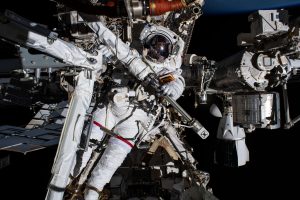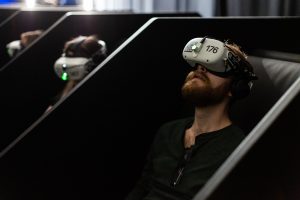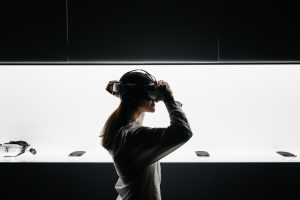
Imagine yourself as an avatar of pulsating lights, sporting a virtual reality (VR) headset and joining an international crew of astronauts aboard the International Space Station (ISS).
You can do just that at the 3-D immersive experience, Space Explorers: The Infinite, now at the Raymond F. Kravis Center for the Performing Arts through September 2.
The state-of-the-art, virtual 3-D replica of the ISS allows viewers to float in space alongside the astronauts and witness the vastness of space and the earth’s sphere, which only that vantage point — 250 miles above earth — allows, all without ever leaving the ground.
“We are proud to bring this exclusive encounter to Florida,” says Diane Quinn, CEO of the Kravis Center. ‘Space Explorers: The Infinite’ beckons, ready to take you on an awe-inspiring journey through the cosmos.” Conceived and produced by Felix & Paul Studios of Montreal, the film is an extension of the Primetime Emmy Award-winning immersive series Space Explorers: The ISS Experience.
Their other projects have included Jurassic Park Blue, Cirque du Soleil: Through the Masks of Luzia and The People’s House: Inside the White House with Barack and Michelle Obama.
A collaboration with Time Studios, the U.S. ISS National Laboratory, NASA and five international space agencies, Space Explorers: The Infinite was filmed over three years, capturing footage onboard the space station using specialized VR camera systems designed to work in microgravity.
Divided into four sections — adapting to the space environment, doing the work of space exploration, cooperating with international partners and looking ahead to the future — the film is experienced differently by each person, depending on which modules they activate.
Ten international astronauts are featured, including American female astronauts Anne McClain, Jessica Meir and Christina Hammock Koch, Americans Nick Hague, Andrew R. Morgan and Victor J. Glover; Canadian David Saint-Jacques and Italian Luca Parmitano, who spent one of the longest times in space, with a total of 366 days.
Also on view is the first U.S. spacewalk performed by Akihiko Hoshide of the Japan Aerospace Exploration Agency (JAXA) and Thomas Pesquet of the European Space Agency (ESA) as they maneuver outside the ISS to install a support bracket for a new set of solar arrays.
The specialized 360-degree camera, designed to withstand the rigors of spaceflight and the harsh environment of space, was mounted to the station’s robotic arm, and allows viewers to watch the spacewalk as if they were right there, working alongside Hoshide and Pesquet.

“This is the first time ever something like this was attempted,” says Félix Lajeunesse, chief creative officer of Felix & Paul Studios. “It’s the most ambitious project filmed outside of the Earth.”
In January 2019, they began filming, documenting the daily lives, work and relationships on six NASA missions to space, culminating with the first ever spacewalk filmed in cinematic VR.
Lajeunesse gives credit to the astronauts’ willingness to participate in the project, despite the rigorous demands of their jobs. He also credits their decisions to provide access to the filmmakers.
“We had an unprecedented level of access,” he says.
“The astronauts opened the doors of the ISS to us and through us to the public,” he says. “They shared a lot of their experiences and perspectives and what it’s like to be one of the 400 people in human history who have gone into space.”
“We owe a lot to these astronauts,” he says.

As the director, Lajeunesse encouraged the astronauts to speak directly to the camera and share their perspectives on the mission, as well as their thoughts and feelings of living in space, especially while the COVID-19 virus was raging on earth.
How does it feel to be a part of a community living in close quarters for a year? How does it feel seeing the earth through the window of the cupola? How does it feel being away from home and family for up to a year?
With more than 250 hours of high-end virtual reality footage, and the positioning of the cameras, visitors sense the astronauts are looking and speaking directly to them.
While most of the scenes were pre-planned, Lajeunesse says the astronauts sometimes took the initiative and went off-script.
In one such instance, at dinner, the astronauts created a special atmosphere, by lighting candles, preparing appetizers and playing jazz music over dinner.
“We were blown away by their initiative,” Lajeunesse remembers. “They took our simple request and turned it into something more creative and interesting.”
The film opened in Montréal in 2021, and has since traveled to Houston, Seattle and San Francisco before touching down in West Palm Beach.
After Florida, the experience heads to Charlotte, N.C., and by the end of this year, they estimate approximately 500,000 people will have seen and experienced what it’s like to live and work on the ISS.
“You need more than one visit to see it all, and every time you come you will see something different,” says Myriam Achard, a spokesperson for the Felix & Paul Studios.

“In our lifetime, only a limited number of people have the opportunity to go up into space,” she says. “This is the closest most people will come to experiencing what it’s like to go into space and see the ISS.”
Achard says she hopes people come away with a feeling of awe and say, “I’m thrilled that I was able to go into space and see the universe. What a beautiful journey.”
Besides the wonders of space, for Lajeunesse, what was most impressive was the dedication and commitment the astronauts bring to their mission.
“It’s unbelievable,” he says. “It’s a dangerous endeavor and an enormous commitment. These astronauts live in a risky environment away from their family and loved ones for extended periods and accomplish extraordinarily difficult missions.”
“It’s very inspiring,” says Lajeunesse.
Looking ahead, he hopes to collaborate again with NASA on the Artemis Program, which will reestablish a sustainable presence on the moon for the first time since Apollo 17 in 1972 and explore Mars and the rest of the solar system.
Now that he’s had a first-hand glimpse into life on the ISS, would he like to go into space?
“For sure,” he says. “If access to space were easier, I’d be the first to sign up.”
Space Explorers: The Infinite runs through September 2 at the Gimelstob Ballroom in the Cohen Pavilion at the Raymond F. Kravis Center for the Performing Arts, 701 Okeechobee Blvd. in West Palm Beach. Tickets start at $45 for adults; $25 for children (ages 8-12) and $35 for students. For tickets visit kravis.org. Age requirement: Designed for ages 13+. Children under the age of 8 will not be admitted. Those aged 8-12 will require a waiver signed by their parent/guardian before beginning the experience.